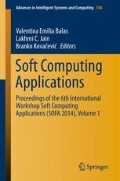Abstract
Motivated by the constantly growing interest and real-world applicability shown in complex networks, we model and optimize the network formed by road networks in cities from an innovative perspective. We detect traffic hotspots which lead to congestion using the betweenness centrality of the road graph. This is shown to have a power-law distribution which we set out to redistribute and equalize. Optimization at a macro-level is not feasible because of the graph size, and thus we recursively narrow down the methodology to a sub-optimization of city neighborhoods. To that end, the paper introduces a genetic algorithm which redistributes betweenness optimization at a neighborhood level, district level, and city level to reduce and/or eliminate congestion hotspots, by changing street directions, without adding any new roads. Experimental results yield an improvement with a factor of 4 times in terms of reducing load off from hotspots and transferring it to neighboring streets.
Access this chapter
Tax calculation will be finalised at checkout
Purchases are for personal use only
References
Strogatz SH (2001) Exploring complex networks. Nature 410(6825):268–276
Wasserman S (1994) Social network analysis: methods and applications, vol 8. Cambridge University Press, Cambridge
Wang XF, Chen G (2003) Complex networks: small-world, scale-free and beyond. IEEE Circuits Syst Mag 3(1):6–20
Easley D, Kleinberg J (2010) Networks, crowds, and markets, vol 8. Cambridge University Press, Cambridge
Barabási A-L, Gulbahce N, Loscalzo J (2011) Network medicine: a network-based approach to human disease. Nat Rev Genet 12(1):56–68
Newman M (2003) The structure and function of complex networks. SIAM Rev 45(2):167–256
Newman ME (2006) Modularity and community structure in networks. Proc Natl Acad Sci 103(23):8577–8582
Barabási A-L (2013) Network science. Philos Trans R Soc Math Phys Eng Sci 371(1987):20120375
Juhlin O (1999) Traffic behaviour as social interaction-implications for the design of artificial drivers. In: Proceedings of 6th world congress on intelligent transport systems (its), Held Toronto, Canada, 8–12 Nov 1999
Jiang B, Duan Y, Lu F, Yang T, Zhao J (2013) Topological structure of urban street networks from the perspective of degree correlations, vol. 1533. arXiv preprint arXiv:1308
Jiang B (2009) Street hierarchies: a minority of streets account for a majority of traffic flow. Int J Geogr Inf Sci 23(8):1033–1048
Tomko M, Winter S, Claramunt C (2008) Experiential hierarchies of streets. Comput Environ Urban Syst 32(1):41–52
Porta S, Crucitti P, Latora V (2006) The network analysis of urban streets: a dual approach. Phys A 369(2):853–866
Bastian M, Heymann S, Jacomy M (2009) Gephi: an open source software for exploring and manipulating networks. In: ICWSM
Blondel VD, Guillaume J-L, Lambiotte R, Lefebvre E (2008) Fast unfolding of communities in large networks. J Stat Mech: Theory Exp 2008(10):P10008
Mitchell M (1998) An introduction to genetic algorithms. MIT Press, Massachusetts
Barabási AL, Albert R (1999) Emergence of scaling in random networks. Science 286(5439):509–512
Acknowledgments
This work was partially supported by the strategic grant POSDRU/159/1.5/S/137070 (2014) of the Ministry of National Education, Romania, co-financed by the European Social Fund—Investing in People, within the Sectoral Operational Programme Human Resources Development 2007–2013.
Author information
Authors and Affiliations
Corresponding author
Editor information
Editors and Affiliations
Rights and permissions
Copyright information
© 2016 Springer International Publishing Switzerland
About this paper
Cite this paper
Topirceanu, A., Iovanovici, A., Cosariu, C., Udrescu, M., Prodan, L., Vladutiu, M. (2016). Social Cities: Redistribution of Traffic Flow in Cities Using a Social Network Approach. In: Balas, V., C. Jain, L., Kovačević, B. (eds) Soft Computing Applications. SOFA 2014. Advances in Intelligent Systems and Computing, vol 356. Springer, Cham. https://doi.org/10.1007/978-3-319-18296-4_4
Download citation
DOI: https://doi.org/10.1007/978-3-319-18296-4_4
Published:
Publisher Name: Springer, Cham
Print ISBN: 978-3-319-18295-7
Online ISBN: 978-3-319-18296-4
eBook Packages: EngineeringEngineering (R0)

